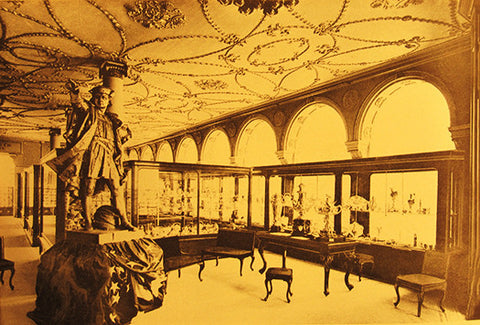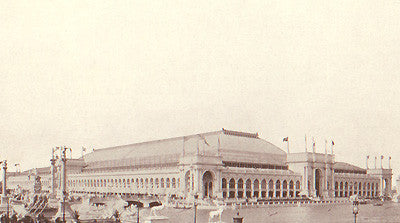Your Cart is Empty
FREE standard shipping to the continental US.
FREE standard shipping to the continental US.
FREE standard shipping to the continental US.

Gorham's outstanding skill at casting was on display for all to see at the Columbian World's Fair – their life sized statue of Columbus was one of the most talked about pieces of silver at the fair. Made from 30,000 ounces of silver (one full ton)1, it was a technical and artistic triumph. The statue dominated the Gorham display. As the New York Times noted about silver at the Columbian Exposition, '…America unquestionably takes first rank, 'and felt specifically of, 'The Gorham Company as representative of this high development in silversmithing.'(1)
During the 19th century, international expositions, or world's fairs, became the most prestigious marketing avenue for luxury retailers. Companies would invest exceptional resources to create their displays. These expositions became the equivalent of selling to royalty during an earlier era: only the very best would do. The publicity surrounding the fair could make, or break, a firm's reputation.
Many of the objects on show were prohibitively expensive to all except the very wealthiest clients. Companies took significant financial risk making these masterpieces. Gorham's Nautilus Centerpiece made for the Columbian Exposition did not sell until 1921, 28 years later.(2)
The 1893 Columbian World's Fair was truly spectacular. To celebrate the 400th anniversary of Columbus finding the new world, an entire city was built on the shores of Lake Michigan in Chicago. It covered 686 acres and included 300 specially constructed buildings.(3)
 The Grand Court of Honor at the World's Columbian Fair 1893
The Grand Court of Honor at the World's Columbian Fair 1893
Chicago architect Daniel Burnham managed the physical construction and maintenance of the facilities. A committee of leading architects involved with the fair including Burnham, Stanford White, Richard Morris Hunt, Louis Sullivan (assisted by a young Frank Lloyd Wright), Frederic Law Olmstead and others chose the theme of classicism to be the signature of the architecture at the fair. Built as a temporary facility, the buildings were constructed in composite materials meant to resemble white marble. The huge park became known as 'The White City.'
During the six months it was open in 1893 there were 27.5 million visitors(4) to the fair, a particularly amazing number in light of the fact that the US census counted 63 million Americans in 1890. Considering that it occurred during a severe economic contraction made it an even greater success.
So successful was the Exposition that it began a massive classical revival at the turn of the century. The most lasting example can be seen today in Washington, D.C. where many federal buildings were built after the fair in the classical style – a permanent 'white city'. (In fact, Burnham worked in Washington, D.C., too: Union Station is his 1903 design. New York's 'Flat Iron Building', generally considered the first 'skyscraper', is also a Burnham design.)

The Manufactures and Liberal Arts Building, where Gorham's exhibit was center stage, was the largest building constructed to date. Three times the size of St. Peter's in Rome, it covered 31 acres with the roof rising 245 feet with no supporting columns in the center.(5) The central hall could 'comfortably' seat 50,000(6) and 150,000 people crowded in on opening day.(7) Gorham's exhibit, next to Tiffany's, was under the central dome where murals by J. Alden Weir displayed the 'Goldsmith's Art'.(8)
In the gold and silverware category, Gorham dominated the exposition. Winning 30 awards, they earned twice the number of prizes of their nearest competitor, Tiffany & Co. who won 15. Included in Gorham's awards were prizes for gilt silver, silver mounted cut glass and crystal, and 'artistic display of exhibit as a whole.'(9) The Royal Museum in Berlin purchased several objects from Gorham at the fair.(10)
The New York Times and other observers noticed Gorham's achievement at the World's Columbian Exposition in 1893. The Gorham designers, directed by William Codman and Antoine Heller, led a group of virtuoso artisans crafting an exhibit that impressed all. The French Government, in their report on the Columbian Exposition, compared Gorham to Tiffany and noted that Gorham, 'is able to produce artistic and decorative work, calling for the highest skilled and careful hand labor.'(11)
By all accounts, Gorham's exhibit at the World's Columbian Exposition was a stunning success. Gorham had met the challenge of the international exhibition and it would be only a few years before they were generally acknowledged to be the leading silversmithing firm in the world. This unique vase of cut crystal with sterling mounts would have been a lovely addition to their display.
This beautiful sterling and glass vase is marked underneath with Gorham's trademark, 'STERLING/ S1040' and with the date mark of 1893. It measures 12 inches high by 6.5 inches across the handles and is in excellent antique condition.
Exhibition History: World's Columbian Exposition, Chicago, 1893.
Endnotes:
Sign up to get the latest updates and current musings in our occasional newsletter…